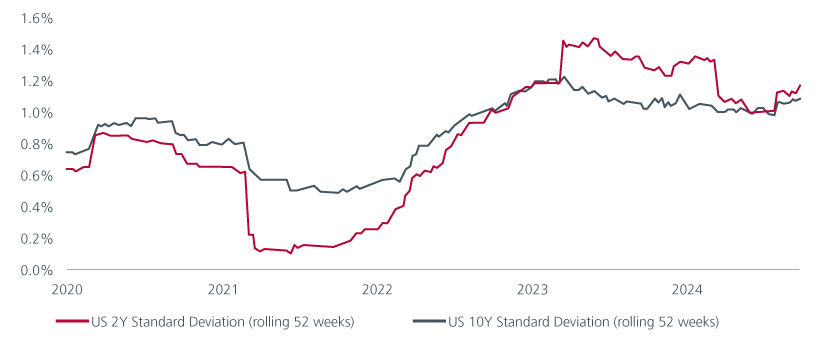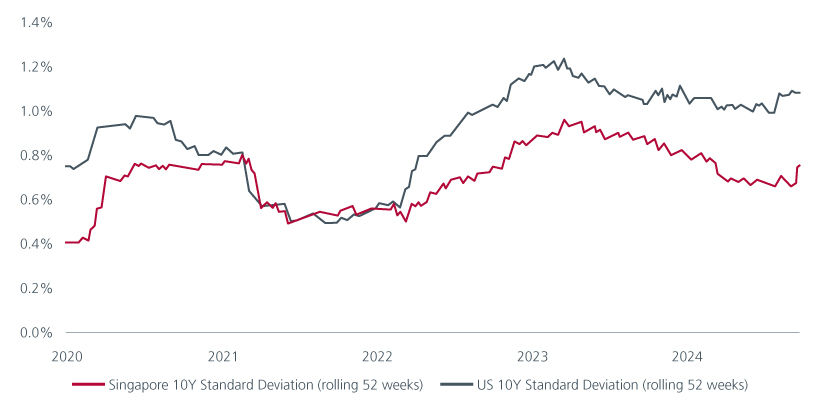Executive Summary
- Similar portfolio duration does not necessarily lead to similar volatility risk
- Duration risk assessment is likely to be more accurate via a granular approach
- Proprietary duration metrics can better capture long-term relationships between tenors and currencies, and help investors to invest with confidence throughout the full monetary cycle
Modified duration, often simply referred as duration, is the measure of a bond’s price sensitivity to interest rate changes. Duration is expressed in years because for a fixed-rate bond, it is mainly a function of the residual maturity of the bond, which is also expressed in years. There is an inverse relationship between the change in bond prices and the change in bond yields; higher bond yields result in lower bond prices, and the longer the bond duration the more severe the bond price decline in response to a 1% increase in bond yields.
1. Do similar durations bear similar risk?
Not necessarily the case. For example, short-term interest rates tend to rise faster than longer-term rates, and they tend to exhibit higher volatility during a monetary tightening cycle than in stable market conditions. As such, a certain amount of duration from a bond maturing in two years versus the same amount of duration from another bond maturing in ten years can exhibit different volatilities. Fig 1. The relative volatility of 2-year bond yields versus 10-year bond yields is typically a function of the stage of the monetary cycle.
Fig 1: Yield volatility of US 2-year government bonds vs US 10-year government bonds

Source: Bloomberg and Eastspring Investments as of 20 Sep 2024
2. Does a bond’s currency denomination impact yield volatility?
It certainly does. In Fig 2, we can see that the volatility of Singapore 10-year government bond yields was on par with the volatility of US 10-year government bond yields during the 18 months following the start of the Covid-19 pandemic. This was when global central banks including the US Federal Reserve and the Monetary Authority of Singapore provided synchronised monetary stimulus that kept interest rates low. However, in the pre and post Covid-19 period, US bond yields were consistently more volatile than Singapore bond yields amid less synchronized global monetary policies.
Fig 2: Yield volatility for US 10-year bonds vs Singapore 10-year bonds

Source: Bloomberg and Eastspring Investments as of 20 Sep 2024
3. Can you illustrate how duration is conventionally used to measure portfolio risk?
The utility of duration is well captured in our Asian bond strategies which hold both US dollar and Asian local currency bonds. Typically, when we construct a bond portfolio, we match the risk characteristics of the benchmark index, plus/minus active positions that we think will help a strategy outperform the index. Usually, the strategy tends to have a duration profile that is comparable to the benchmark.
In Fig 3, you can see that one particular strategy had an overall duration of 4.8 years with 3.35 years coming from US dollar bonds and the rest from Asia local currency bonds. The benchmark index, which is 100% in US dollar bonds, had a duration of 4.45 years. The active duration, the difference between the portfolio duration and the benchmark duration, is 0.35 years with a duration overweight in Asia local currencies, especially in Singapore dollar, and a duration underweight in US dollar.
Fig 3: Duration breakdown by currency

Source: Eastspring Investments as at end Dec 2023
In Fig 4, we decompose the portfolio, benchmark and active durations by residual maturity; the portfolio has an overweight to intermediate and long maturities and an underweight to short-dated bonds. The total active duration is the same as in Fig 3 (0.35 years), but we use a different dimension to decompose the number i.e. residual maturity as opposed to currency.
Fig 4: Duration breakdown by residual maturity

Source: Eastspring Investments as at end Dec 2023
As per the above duration breakdown examples, looking only at the headline active duration number can lead one to conclude that the strategy is unequivocally bullish due to the duration overweight. Such a conclusion would be incorrect, and a more granular approach is required.
4. Are there more dimensions that need to be considered in your interest rate risk assessment?
As we saw from historical volatility charts, one unit of duration risk from a single bond may result in more or less volatility risk depending on the time to maturity1, the stage of the monetary cycle and the bond’s currency.
By adjusting for volatilities and correlations between tenors and currencies, one can better assess the risk of the portfolio, particularly its risk relative to the benchmark index. Ignoring those relationships may lead you to ill-informed investment decisions such as having excessive interest rate sensitivity or lacking that interest rate sensitivity.
In Fig 5, we show how the active duration can change from a positive number (+0.35) when using the conventional duration measure, which we discussed previously, to a negative number (-0.33) after adjusting for long-term volatilities and correlations between tenors and countries.
The negative adjusted duration is mainly driven by the strategy’s allocation to Singapore dollar-denominated bonds, at the expense of US dollar-denominated bonds, given the relatively lower volatility of Singapore government bond yields vs the US government bond yields as we saw earlier.
Fig. 5 : Conventional duration versus beta-adjusted duration

Source: Eastspring Investments as at end Dec 2023
Our proprietary adjusted duration measures are typically calibrated using long-term covariances to better capture expected relationships between tenors and currencies over a full economic cycle. This means that assuming those long-term relationships hold, the above-mentioned strategy is actually more defensive (-0.33) than what the conventional active duration measure (+0.35) suggests.
5. Given that Fed has begun easing, how is duration shaping your portfolios?
Over the past year, USD rate volatility has increased significantly. Market participants initially anticipated policy easing from the Fed, only to recalibrate their expectations in response to prevailing US economic conditions, which influenced the Fed’s policy trajectory. The resilience of the US labour market and persistent inflation in the services sector have particularly complicated the long-duration trade—traditionally seen as a strategy to capitalise on rate rallies when the Fed begins easing.
Duration in other currency markets is expected to perform well alongside USD duration as the Fed cuts rates or signals an upcoming cut. Investing in the duration of these markets offers the added benefit of reducing portfolio volatility when expressing a policy easing view, which can be advantageous given that the rate trajectory may not follow a linear path.
As we incorporate non-USD duration into our portfolios to reflect our constructive duration outlook, a beta-adjusted duration analysis provides a more precise way to assess volatility contributions. This approach will support active rebalancing as market conditions evolve.
Sources:
1 Refers to fixed-rate bonds
The information and views expressed herein do not constitute an offer or solicitation to deal in shares of any securities or financial instruments and it is not intended for distribution or use by anyone or entity located in any jurisdiction where such distribution would be unlawful or prohibited. The information does not constitute investment advice or an offer to provide investment advisory or investment management service or the solicitation of an offer to provide investment advisory or investment management services in any jurisdiction in which an offer or solicitation would be unlawful under the securities laws of that jurisdiction.
Past performance and the predictions, projections, or forecasts on the economy, securities markets or the economic trends of the markets are not necessarily indicative of the future or likely performance of Eastspring Investments or any of the strategies managed by Eastspring Investments. An investment is subject to investment risks, including the possible loss of the principal amount invested. Where an investment is denominated in another currency, exchange rates may have an adverse effect on the value price or income of that investment. Furthermore, exposure to a single country market, specific portfolio composition or management techniques may potentially increase volatility.
Any securities mentioned are included for illustration purposes only. It should not be considered a recommendation to purchase or sell such securities. There is no assurance that any security discussed herein will remain in the portfolio at the time you receive this document or that security sold has not been repurchased.
The information provided herein is believed to be reliable at time of publication and based on matters as they exist as of the date of preparation of this report and not as of any future date. Eastspring Investments undertakes no (and disclaims any) obligation to update, modify or amend this document or to otherwise notify you in the event that any matter stated in the materials, or any opinion, projection, forecast or estimate set forth in the document, changes or subsequently becomes inaccurate. Eastspring Investments personnel may develop views and opinions that are not stated in the materials or that are contrary to the views and opinions stated in the materials at any time and from time to time as the result of a negative factor that comes to its attention in respect to an investment or for any other reason or for no reason. Eastspring Investments shall not and shall have no duty to notify you of any such views and opinions. This document is solely for information and does not have any regard to the specific investment objectives, financial or tax situation and the particular needs of any specific person who may receive this document.
Eastspring Investments Inc. (Eastspring US) primary activity is to provide certain marketing, sales servicing, and client support in the US on behalf of Eastspring Investment (Singapore) Limited (“Eastspring Singapore”). Eastspring Singapore is an affiliated investment management entity that is domiciled and registered under, among other regulatory bodies, the Monetary Authority of Singapore (MAS). Eastspring Singapore and Eastspring US are both registered with the US Securities and Exchange Commission as a registered investment adviser. Registration as an adviser does not imply a level of skill or training. Eastspring US seeks to identify and introduce to Eastspring Singapore potential institutional client prospects. Such prospects, once introduced, would contract directly with Eastspring Singapore for any investment management or advisory services. Additional information about Eastspring Singapore and Eastspring US is also is available on the SEC’s website at www.adviserinfo.sec. gov.
Certain information contained herein constitutes "forward-looking statements", which can be identified by the use of forward-looking terminology such as "may", "will", "should", "expect", "anticipate", "project", "estimate", "intend", "continue" or "believe" or the negatives thereof, other variations thereof or comparable terminology. Such information is based on expectations, estimates and projections (and assumptions underlying such information) and cannot be relied upon as a guarantee of future performance. Due to various risks and uncertainties, actual events or results, or the actual performance of any fund may differ materially from those reflected or contemplated in such forward-looking statements.
Eastspring Investments companies (excluding JV companies) are ultimately wholly-owned / indirect subsidiaries / associate of Prudential plc of the United Kingdom. Eastspring Investments companies (including JV’s) and Prudential plc are not affiliated in any manner with Prudential Financial, Inc., a company whose principal place of business is in the United States of America.















